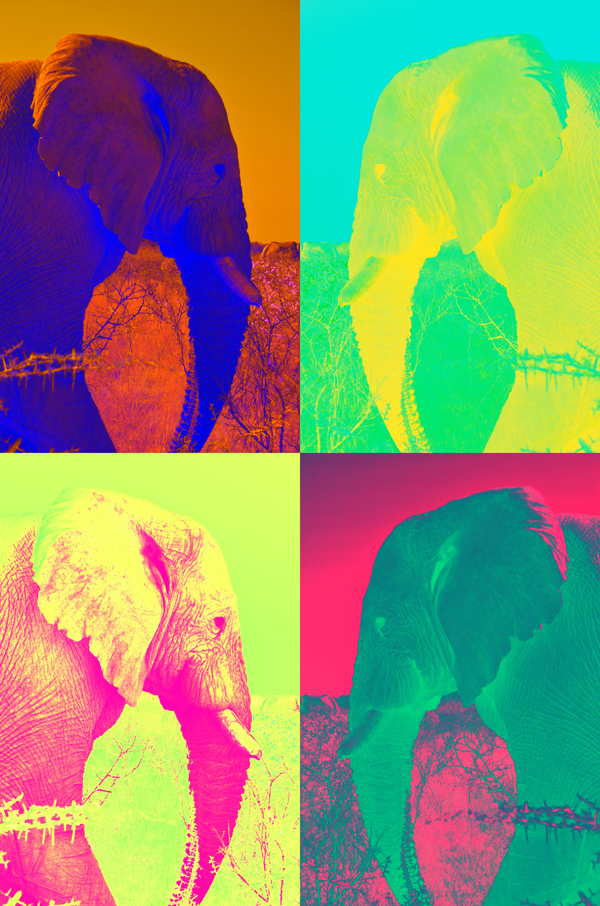Article from http://blogs.mathworks.com
I'd like to welcome back guest blogger Brett Shoelson for the continuation of his series of posts on implementing image special effects in MATLAB. Brett, a contributor for the File Exchange Pick of the Week blog, has been doing image processing with MATLAB for almost 20 years now.
Contents

imadjust as an Image Enhancement Tool
In my previous post in this guest series, I introduced my image adjustment GUI, and used it to enhance colors in modified versions of images of a mandrill and of two zebras. For both of those images, I operated on all colorplanes uniformly; i.e., whatever I did to the red plane, I also did to green and blue. The calling syntax forimadjust is as follows:
imgOut = imadjust(imgIn,[low_in; high_in],[low_out; high_out],gamma);
The default inputs are:
imgOut = imadjust(imgIn,[0; 1],[0; 1],1);
Different input parameters will produce different effects. In fact, imadjust should often be the starting point for simply correcting illumination issues with an image:
URL = 'http://blogs.mathworks.com/pick/files/DrinkingZebra1.jpg';
img = imrotate(imread(URL),-90);
enhanced = imadjust(img,[0.00; 0.35],[0.00; 1.00], 1.00);
subplot(1,2,1);imshow(img);title('Original');
subplot(1,2,2);imshow(enhanced);title('|imadjust|-Enhanced');

You may recall that when I modified the image of two zebras in my previous post, I not only increased low_out, but I also reversed (and tweaked) the values for low_out and high_out:
imgEnhanced = imadjust(imgEnhanced,[0.30; 0.85],[0.90; 0.00], 0.90);
In reversing those input values, I effectively reversed the image. In fact, for a grayscale image, calling
imgOut = imadjust(imgIn,[0; 1],[1; 0],1); % Note the reversal of low_out and high_out
is equivalent to calling imgOut = imcomplement(imgIn):
img = imread('cameraman.tif');
img1 = imadjust(img,[0.00; 1.00],[1.00; 0.00], 1.00);
img2 = imcomplement(img);
assert(isequal(img1,img2))% No error is thrown!
figure;subplot(1,2,1);imshow(img);xlabel('Original image courtesy MIT');
subplot(1,2,2);imshow(img1);

Now recognize that ImadjustGUI calls imadjust behind the scenes, using the standard syntax. If you read the documentation for imadjust carefully, you will learn that the parameter inputs low_in, high_in, low_out, high_out, and gamma need not be scalars. In fact, if those parameters are specifed appropriately as 1-by-3 vectors, then imadjust operates separately on the red, green, and blue colorplanes:
newmap = imadjust(map,[low_in; high_in],[low_out; high_out],gamma)
% ...transforms the colormap associated with an indexed image.
% If low_in, high_in, low_out, high_out, and gamma are scalars, then the
% same mapping applies to red, green, and blue components.
%
% Unique mappings for each color component are possible when low_in and
% high_in are both 1-by-3 vectors, low_out and high_out are both 1-by-3 vectors,
% or gamma is a 1-by-3 vector.
That works for adjusting colormaps; it also works for adjusting images. As a result, you can readily reverse individual colorplanes of an input RGB image, and in doing, create some cool effects!
Andy Warhol Meets an Elephant
Andy Warhol famously created iconic images of Marilyn Monroe and other celebrities, casting them in startling, unexpected colors, and sometimes tiling them to create memorable effects. We can easily produce similar effects by reversing and saturating individual colorplanes of RGB images. (I wrote ImadjustGUI to facilitate, interactively, those plane-by-plane intensity adjustments.)

Reading and Pre-Processing the Elephant
First, of course, we read and display the elephant:
URL = 'http://blogs.mathworks.com/pick/files/ElephantProfile.jpg';
img = imread(URL);
He's a wrinkly old fellow (below left). I'd like to bring out those wrinkles by enhancing contrast in the image. There are a few ways to do that, but I learned about my favorite way by reading through the "Gray-Scale Morphology" section of DIPUM, 2nd Ed. Specifically, the authors of this (most excellent) book indicated (on page 529) that one could combine topat and bottomhat filters to enhance contrast. (I built the appropriate combination of those filters behind the "Contrast Enhancement" button of MorphTool.) So, using MorphTool-generated code:
SE = strel('Disk',18);
imgEnhanced = imsubtract(imadd(img,imtophat(img,SE)),imbothat(img,SE));

Now, operating with imadjust plane by plane, reversing the red and blue planes, and modifying the gamma mapping, I can easily find my way to several interesting effects. For instance:
imgEnhanced1 = imadjust(imgEnhanced,[0.00 0.00 0.00; 1.00 0.38 0.40],[1.00 0.00 0.70; 0.20 1.00 0.40], [4.90 4.00 1.70]);
imgEnhanced2 = imadjust(imgEnhanced,[0.13 0.00 0.30; 0.75 1.00 1.00],[0.00 1.00 0.50; 1.00 0.00 0.27], [5.90 0.80 4.10]);

So, two more of those interesting effects, and then we can compose the four-elephants image above:
imgEnhanced3 = imadjust(img,[0.20 0.00 0.09; 0.83 1.00 0.52],[0.00 0.00 1.00; 1.00 1.00 0.00], [1.10 2.70 1.00]);
imgEnhanced4 = imadjust(img,[0.20 0.00 0.00; 0.70 1.00 1.00],[1.00 0.90 0.00; 0.00 0.90 1.00], [1.30 1.00 1.00]);
I also wanted to flip two of those enhanced images. fliplr makes it easy to flip a 2-dimensional matrix, but it doesn't work on RGB images. So I flipped them plane-by-plane, and concatenated cat the flipped planes in the third ( z -) dimensioninto new RGB images:
r = fliplr(imgEnhanced2(:,:,1));
g = fliplr(imgEnhanced2(:,:,2));
b = fliplr(imgEnhanced2(:,:,3));
imgEnhanced2 = cat(3,r,g,b);
CompositeImage = [imgEnhanced1 imgEnhanced2; imgEnhanced3 imgEnhanced4]; % (Images 2 and 4 are flipped plane-by-plane.)
Next Up: Put Me In the Zoo!

All images except "cameraman" copyright Brett Shoelson; used with permission.

No comments:
Post a Comment